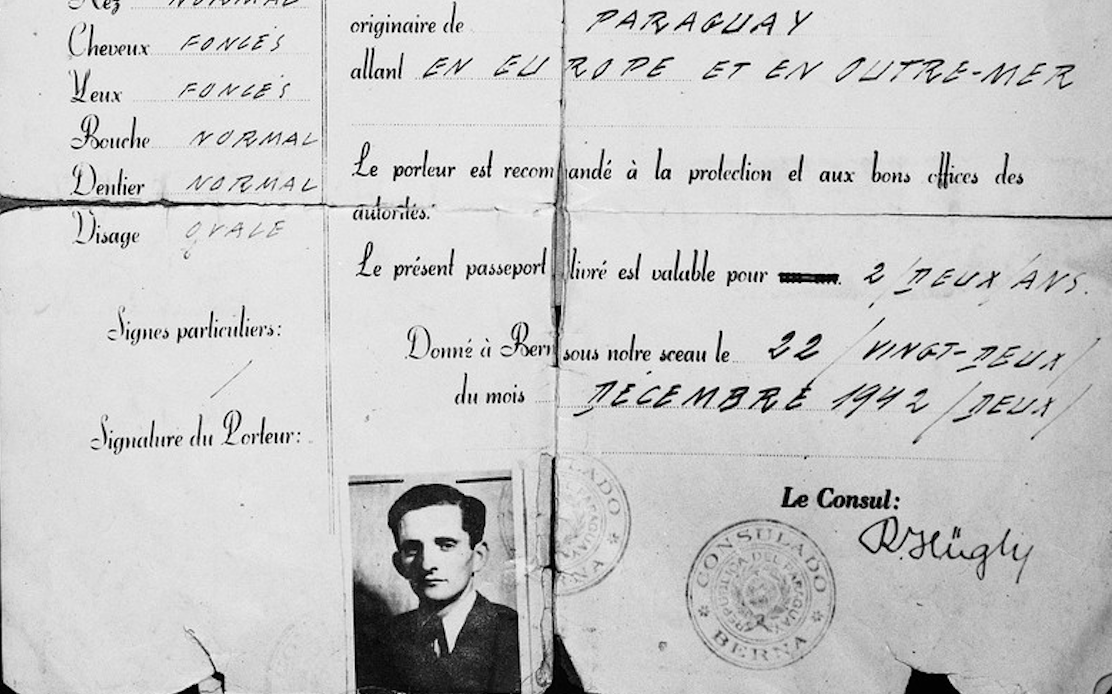The Master Forgers Who Saved Thousands of Lives During World War II
From the Polish embassy in Switzerland came a campaign that spared many from Nazi extermination.

A few years ago, at a reception at the Polish embassy in Bern, Switzerland, an elderly Jewish man pulled the ambassador aside and relayed an unbelievable story. They were standing on holy ground, the man said, a place where near-secret acts of heroism played out during World War II. Intrigued, the ambassador, Jakob Kumoch, tasked his staff with looking into the man’s claims. Soon, an incredible history emerged.
Each month, this column will explore the slivers of our society that, over the years, have connived, deceived, and stolen—the psychological twists of heists and cons. This story is full of illegality and duplicity, but it doesn’t otherwise fit the category neatly. In this case, the crime was a moral imperative, and when presented with the opportunity, the government officials involved didn’t hesitate to commit illicit acts.
In October 2023, British historian Roger Moorehouse released The Forgers, which unravels the previously untold story of this daring campaign to rescue European Jews. To pull it off, the Polish government, operating in exile after the German occupation in 1939, forged around 10,000 Latin American passports that helped Jews across the continent escape almost certain death.
They were known as the Ładoś Group, for their leader, the Polish chargé d’affaires to Switzerland, Aleksander Ładoś. The group was made up of four diplomats working out of the Polish embassy in Bern, along with two humanitarian representatives. Three of the six were Jewish.
At the time, Switzerland, an island of democracy amid a rising sea of totalitarianism, was abuzz with spies, diplomats, refugees, and humanitarians. But tensions were high: To maintain their neutrality and autonomy, the Swiss hesitated to blatantly resist Hitler’s Reich.
When Ładoś arrived in Bern in the spring of 1940 as the new Polish envoy, the embassy staff was unimpressed. He was a far cry from Titus Komarnicki, his productive, bustling predecessor. In fact, Ładoś spent most of his days lying on his office couch, in a haze of cigar smoke. But beneath that lazy exterior was a man with a dramatic past: a politician, fighter, and journalist who had been exiled from Poland by Austrian authorities during World War I. To smuggle himself into Switzerland at that time, he’d used a forged passport. Two decades later, Ładoś and the rest of the Polish political class were on the run again. As he escaped the Nazi occupation on a long journey to the Romanian border, one act of kindness stuck with him: the refuge he was given by a Jewish family.

To Poles of that generation, extraordinary circumstances required extraordinary measures, and rule-bending was a necessity of daily life. Since 1795 their land had been ruled by a nearly unbroken chain of occupiers, and they had learned to live in a state of conspiratzia. That meant, according to Moorehouse, that though the Poles appeared to comply with foreign authorities, “beneath the table [they] were producing a Polish nationalist newspaper or collecting weapons.” So when Hitler’s forces invaded and occupied Poland, conspiratzia kicked into high gear. By the end of the war, the Polish resistance outnumbered every other such movement in Europe.
“To the Poles,” says Moorehouse, “illegal activity in the name of a higher purpose was absolutely acceptable.”
While the world debated what to do about the seismic humanitarian crisis brewing on the continent, sparked by Hitler’s rapacious ambitions, no nation came forward to offer refuge. Instead, led by the inaction of the United States, politicians rested on the laurels of bureaucracy, red tape, even appeasement.
That didn’t suit Ładoś and his diplomatic staff, who continued to operate as representatives of an independent Polish government in exile. For three years in the early 1940s, this tiny group pulled off one of the largest rescue operations in Europe. The idea formed around 1940: Using the tools of crime—forgery, specifically—the embassy staff saw a route to help. A staffer in the Paraguayan embassy was willing to provide them with blank passports. These, they determined, could help Jews travel across and out of the Soviet Union, which at the time was allowing neither Soviet Jews to exit nor Polish Jews to transit through. From there, these escaping travelers could then seek transit visas to Japan or elsewhere, via helpful diplomats in other Polish embassies. Sketchy as this route was, it was far better than staying under increasingly repressive and violent German—or Soviet—rule.

In the coming year, as the murder of Jews became a matter of German policy, desperate, coded letters flooded into the embassy from across the continent. The passports were already becoming unlikely to offer safe relocation, but they could still serve as a last resort to be brandished in critical moments. They could mean the difference between life and death.
Jews in Nazi-controlled territory were being shipped en masse to extermination camps, but Germany had decided to reroute those with foreign passports to detention camps. In these places, such as Bergen-Belsen in Germany, they were still at risk of disease, starvation, and violence, but may not have been immediately condemned to the gas chambers.
In time, the Polish embassy would facilitate false passports for Jews in Poland, the Netherlands, Slovakia, Hungary, and Germany. They were most often in the name of Paraguay, but also Peru, El Salvador, Honduras, and Haiti, all of which would join the Allied powers. While Germany likely had suspicions about these newly minted Latin American Jews, many of whom couldn’t pick out their “home” countries on a map, they were seemingly ignored by authorities: The Nazis likely hoped these alleged foreigners could someday be traded for German citizens stuck abroad.

“The reaction people have to the Holocaust going on in their midst is a spectrum, from exploiting it to risking your life,” says Moorehouse. The difference between those at each end was moral clarity and bravery. For Ładoś and his team of willing forgers, there was no second thought. “The primary concern for them is they feel the need to do something and they are doing the right thing.”
To protect themselves and the passport holders, the Ładoś Group worked in complete secrecy, even from their superiors in the Polish government, based at that time in London. But once the central government got word of the scheme, they weren’t angry—they wanted in. In 1943, they showed just how deep conspiratzia ran in the Polish psyche: They wrote to Ładoś saying they’d heard it was possible to produce Latin American passports—years after Ładoś had already started the scheme. When word got out, some Latin American countries hemmed and hawed about recognizing these unauthorized passports, and Germany took the opportunity to send thousands of so-called “Exchange Jews” to their deaths. But thousands more remained protected by their foreign status, and saw the war’s end by clinging to the fragile papers that had arrived, mysteriously, from Switzerland.
The Ładoś Group may have been among the most prolific forgers, but they weren’t the only people using skills that would have been illicit during peacetime to do something just in the chaos of the war. Deceptions of all kinds, forgeries among them, saved tens of thousands of lives during World War II.
In Paris, a young Argentinian Jew named Adolfo Kaminsky churned out a daily stream of false baptismal records, ration cards, and identity papers for French Jews. Using stain-removing techniques he’d been taught by a chemical engineer in a textile factory in Normandy and typesetting he’d learned as the editor of his elementary school newspaper, the teenager created thousands of forged documents. His papers also helped French undercover agents sneak into Nazi territory to document death camps and, later, insurgencies in Algeria, South Africa, and Latin America. He even aided American draft dodgers during the Vietnam War.
In Slovakia, Jewish typographer Adolf Burger was printing fake baptismal records for Jews who were on deportation lists when he was arrested by the Gestapo. Shipped to Auschwitz, his talent as a printer saved him from the gas chambers. But this came at a price: Taken to a camp outside Berlin, he was enlisted in Operation Bernhard, the Nazi effort to counterfeit British currency, postage stamps, and passports, alongside 140 other prisoners. The Nazis hoped to flood the British economy with fake currency to destabilize the nation. They planned to do the same to the United States.

“[T]he Nazis were not just murderers,” Burger later said, “they were common criminals.”
After the war, the incredible story of Ładoś and his forgers vanished. Ładoś joined the Polish opposition party and moved to France. Other members of the group left the diplomatic corps and pursued business ventures in Switzerland. One emigrated to Argentina, another to the United States. All the while, the records of their wartime heroism remained buried deep in the archives of the exiled Polish government, which only returned to Poland in 1990, after the Soviet-backed government fell. To further the mystery, those who received their passports rarely knew where they’d come from. It was not part of the official narrative of the war, nor the personal stories of those who survived the Holocaust—so it was widely forgotten.
Forgotten, that is, until the elderly man, a Swiss Jew, told the story to the Polish ambassador at that party in Bern, and later, Moorehouse caught wind of it. “Potentially,” says Moorehouse, “you have thousands of people out there in the U.S. and elsewhere, who have one of these Paraguayan passports in their family story.”
Nina Strochlic covers stories about migration, conflict, and interesting people across the globe. She was previously a staff writer for National Geographic, Newsweek, and the Daily Beast. She cofounded the Milaya Project, a nonprofit working with South Sudanese refugees in Uganda.











Follow us on Twitter to get the latest on the world's hidden wonders.
Like us on Facebook to get the latest on the world's hidden wonders.
Follow us on Twitter Like us on Facebook